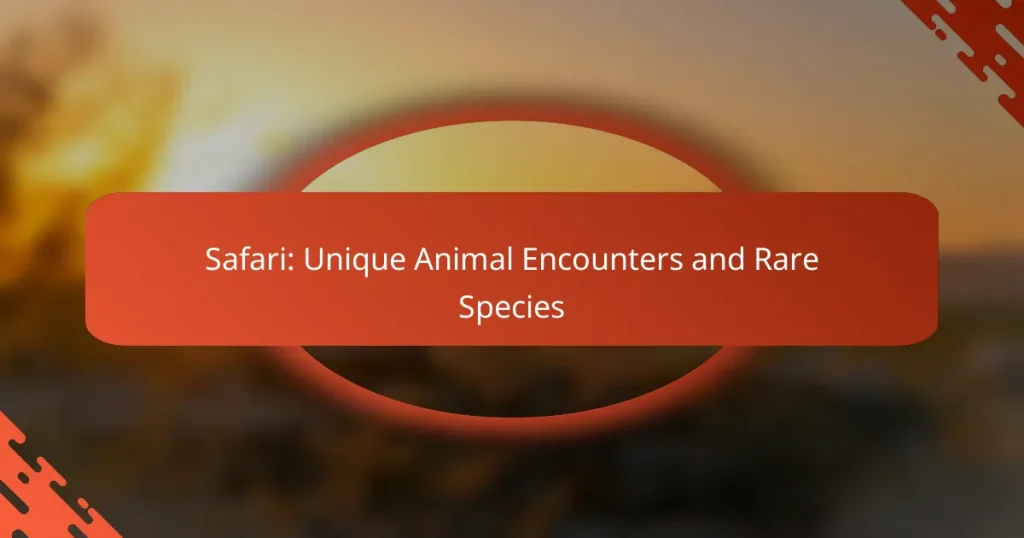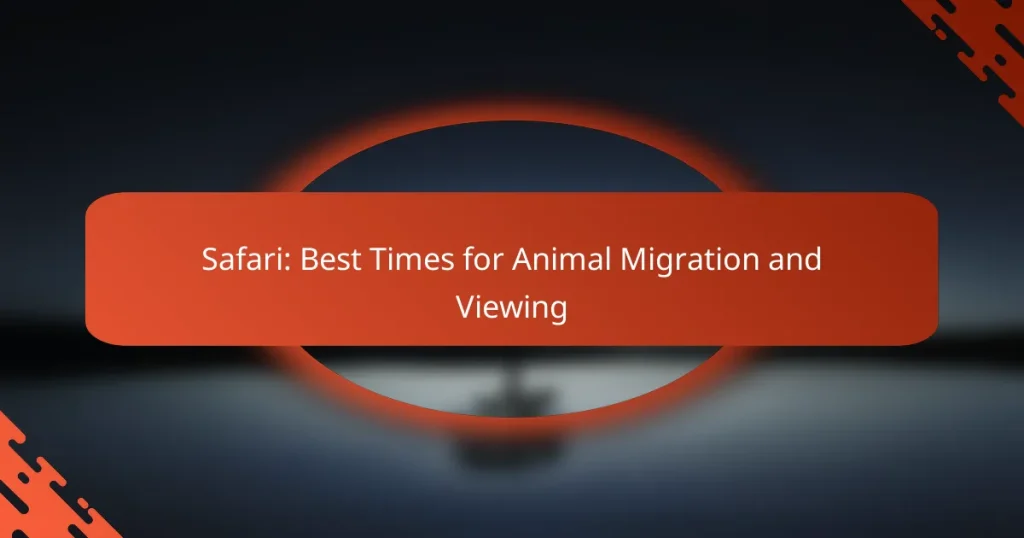Embarking on a safari tour offers an unparalleled chance to observe wildlife in their natural environments, with iconic locations like Serengeti National Park and Kruger National Park providing breathtaking experiences. Selecting the right tour requires careful consideration of wildlife viewing opportunities, itinerary, and accommodation to ensure a memorable adventure. With a range of options from budget-friendly to luxurious, there’s a safari experience to suit every traveler’s needs.
Safari: Top Animals to Spot, Unique Species, and Viewing Tips
Safari: Wildlife Conservation Efforts and Ecosystem Support
Safari: Animal Behavior Insights and Expectations
Safari: Best Times for Animal Migration and Viewing
Safari: Responsible Wildlife Viewing and Ethical Practices
What are the best safari tours in Africa?
The best safari tours in Africa offer unique opportunities to witness diverse wildlife in their natural habitats. Popular destinations include Serengeti National Park, Kruger National Park, Masai Mara, Chobe National Park, and Etosha National Park, each providing distinct experiences and landscapes.
Serengeti National Park Tours
Serengeti National Park is renowned for its annual wildebeest migration, making it a top choice for safari enthusiasts. Tours typically range from budget camping options to luxury lodges, allowing visitors to choose their preferred level of comfort.
When planning a Serengeti tour, consider the timing of the migration, which usually occurs between June and October. Booking in advance is advisable, especially during peak season, to secure the best accommodations.
Kruger National Park Safaris
Kruger National Park is one of Africa’s largest game reserves, offering self-drive and guided safari options. Visitors can expect to see the Big Five—lion, leopard, elephant, buffalo, and rhinoceros—along with a variety of other wildlife.
Safaris in Kruger can be tailored to different budgets, with options ranging from basic campsites to upscale lodges. It’s essential to familiarize yourself with park regulations and safety guidelines, especially if opting for self-driving.
Masai Mara Wildlife Experiences
The Masai Mara is famous for its rich wildlife and cultural experiences with the Maasai people. This region is particularly vibrant during the Great Migration, where millions of animals traverse the plains.
Most tours include game drives, but consider adding a hot air balloon ride for a unique perspective of the landscape. Ensure your tour operator is reputable and offers responsible wildlife viewing practices.
Chobe National Park Adventures
Chobe National Park, located in Botswana, is known for its large elephant population and stunning riverfront views. Boat safaris along the Chobe River provide a different vantage point to observe wildlife.
When visiting Chobe, consider combining your trip with a visit to nearby Victoria Falls for a complete experience. Be aware of the seasonal variations in wildlife visibility, as certain times of the year may offer better sightings.
Etosha National Park Expeditions
Etosha National Park in Namibia is characterized by its salt pans and diverse ecosystems. The park is home to a variety of wildlife, including endangered species, making it a significant conservation area.
Self-drive safaris are popular in Etosha, allowing for flexibility in exploring the park. Be sure to check for accommodation options within the park, as staying overnight can enhance your wildlife viewing opportunities, especially during early morning and late afternoon hours.
How to choose the right safari tour?
Choosing the right safari tour involves assessing various factors to ensure an unforgettable wildlife experience. Key considerations include wildlife viewing opportunities, tour duration and itinerary, accommodation options, and the expertise of your guides.
Consider wildlife viewing opportunities
Wildlife viewing opportunities are central to any safari experience. Research the specific animals you want to see and the best times of year for sightings, as this can vary by region. For instance, the Serengeti in Tanzania is renowned for the Great Migration, typically occurring between June and October.
Look for tours that offer flexible itineraries allowing for spontaneous wildlife encounters. Some operators provide options for night drives or walking safaris, which can enhance your chances of seeing elusive species.
Evaluate tour duration and itinerary
Tour duration and itinerary significantly impact your safari experience. Short tours, lasting a few days, may limit your wildlife encounters, while longer tours, spanning a week or more, often provide a more comprehensive experience. Consider how much time you can dedicate to travel and exploration.
Review the daily itinerary to ensure it includes ample time for game drives and other activities. A well-structured itinerary balances travel time with wildlife viewing, allowing for both relaxation and adventure.
Assess accommodation options
Accommodation options can vary widely from luxury lodges to budget camping. Determine your comfort level and budget to find the right fit. Luxury lodges often provide more amenities and guided experiences, while camping can offer a more immersive experience with nature.
Check the location of accommodations in relation to wildlife hotspots. Staying within or near national parks can enhance your chances of seeing animals right from your lodge or tent.
Review guide expertise and experience
The expertise and experience of your safari guide can greatly influence your tour. Knowledgeable guides can enhance your understanding of wildlife behavior and ecology, making the experience more enriching. Look for guides with certifications or extensive experience in the region.
Read reviews or ask for recommendations to ensure you choose a tour operator that employs skilled guides. A good guide can also help you navigate the best viewing spots and share fascinating insights about the local ecosystem.
What are the costs of safari tours?
The costs of safari tours can vary significantly based on factors such as the type of safari, duration, and included amenities. Budget safaris may start at a few hundred dollars, while luxury experiences can reach several thousand dollars per person.
Average prices for budget safaris
Budget safaris typically range from around $100 to $300 per day. These tours often include basic accommodations, shared transportation, and some meals. Travelers should expect to participate in group activities and may have limited access to exclusive wildlife experiences.
When considering a budget safari, look for options that provide good value, such as those that include park fees and meals. Researching local operators can help find affordable packages that still offer memorable wildlife encounters.
Mid-range safari tour costs
Mid-range safari tours generally cost between $300 and $800 per day. These packages often feature better accommodations, private transportation, and guided tours. Travelers can enjoy a more personalized experience with additional amenities like meals at nicer lodges.
For a mid-range safari, consider factors such as the number of game drives included and the quality of the lodges. It’s wise to read reviews and compare itineraries to ensure a fulfilling experience that meets your expectations.
Luxury safari pricing
Luxury safaris can range from $800 to several thousand dollars per day, depending on the exclusivity of the experience. These tours often include high-end lodges or tented camps, gourmet meals, and private guides. Travelers can expect top-notch service and unique experiences such as private game drives or exclusive access to wildlife reserves.
When planning a luxury safari, consider the level of personalization and the types of activities offered. Look for packages that include unique experiences, such as hot air balloon rides or guided walking safaris, to enhance your adventure.
What wildlife can you expect to see on safari?
On safari, you can expect to encounter a diverse range of wildlife, including iconic species and unique animals native to specific regions. The experience varies greatly depending on the location, time of year, and type of safari you choose.
The Big Five: Lions, Elephants, Buffalos, Leopards, Rhinos
The Big Five refers to five of the most sought-after animals to see on safari: lions, elephants, buffalos, leopards, and rhinos. These species are not only impressive in size and behavior but also hold significant cultural and economic importance in wildlife tourism.
When planning your safari, consider that the best locations for viewing the Big Five include renowned parks like the Serengeti in Tanzania and Kruger National Park in South Africa. Each park offers unique opportunities to see these animals in their natural habitats.
Unique species in specific parks
Many national parks are home to unique species that are not found elsewhere. For instance, the Okavango Delta in Botswana is famous for its large populations of African wild dogs, while Madagascar’s national parks host lemurs that are endemic to the island.
When visiting specific parks, research the unique wildlife they offer to enhance your safari experience. This can help you target your trip to see rare species and participate in conservation efforts.
Seasonal wildlife migrations
Seasonal wildlife migrations, such as the Great Migration in East Africa, showcase the movement of millions of wildebeest and zebras in search of food and water. This event typically occurs between June and October, offering spectacular viewing opportunities.
Timing your safari to coincide with these migrations can significantly enhance your experience. Be aware that the exact timing can vary each year based on weather patterns, so check local conditions and consult with tour operators for the best chances to witness these migrations.





